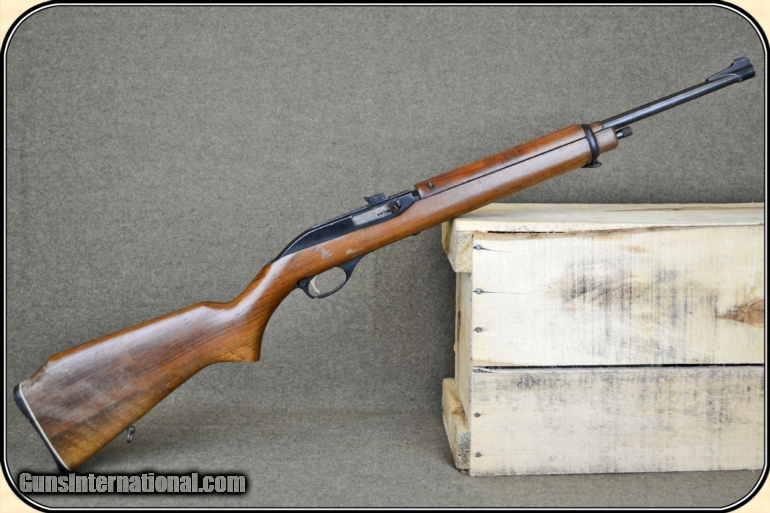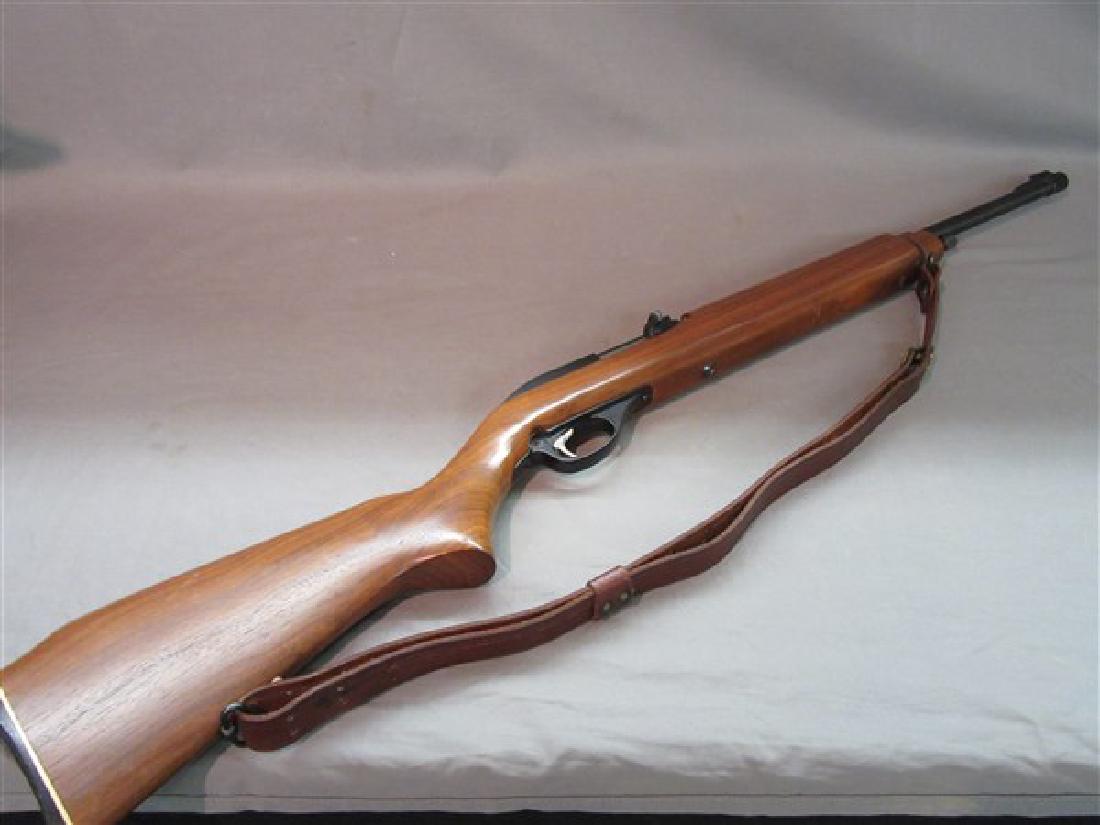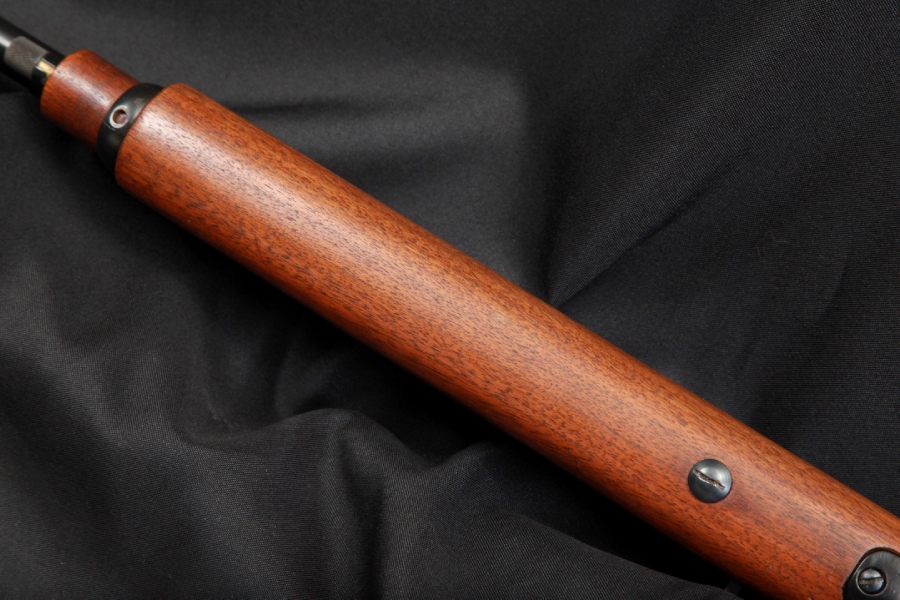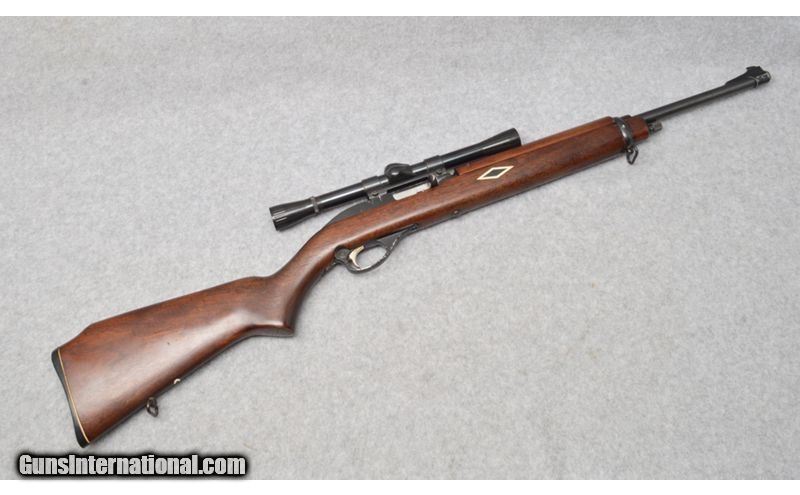Interesting Guns No. 85
I had to work on saturday so I took a trip to the gun show today to find a near mint Marlin Model 99 M1.22 rifle. I saw it on a dealers table and I really thought it was some kind of special re-issue. Super clean with some tiny, tiny dings on the wood. $159 private sale:cool: I asked the. MARLIN MODEL 99 M1 ORIGINAL VINTAGE BARREL/STOCK BAND GOOD CONDITION. FULLY FUNCTIONAL INCLUDES SET SCREW Up for auction today is an vintage original barrel/stock band for the Marlin Model 99 M1. Includes the set screw. Part is in decent shape and fully functional, but may have some scrapes and scuffs here and there.
Marlin’s Levermatic Rifle Line
Offered Untraditional Design
by John Malloy
Contributing Editor to The New Gun Week
The Marlin LThis specimen is one of the first manufactured—a .22-caliber Model 56 with a 24-inch barrel and serial numbered in the 1,000 range. evermatic was a full-size rifle with a unique short-stroke lever action.
The Marlin Firearms Company has been known since 1881 for their line of traditionally-styled lever-action rifles. All Marlin lever guns made today look very much like the rifles that the company made in its earliest days. They have a certain characteristic look about them. They have outside hammers, finger levers that move about 90 degrees to operate the action, and have tubular magazines.
However, for a relatively short time in the late 1950s and 1960s, Marlin made lever-action rifles that were very different from the traditional pattern. With a speed of operation between the traditional lever action and the semi-automatic, these interesting guns were called the “Levermatic” rifles.
The Levermatic story actually began around 1950 with the Kessler Arms Company of Silver Creek, NY. The Kessler company made inexpensive bolt-action shotguns which were sold under many names. The Kessler guns were available at a time when the post-WWII interest in hunting and shooting had increased the demand for affordable firearms. The Kessler company only remained in business for about three years, but during that time, made over three-quarters of a million shotguns. Toward the end of its existence, the Kessler firm introduced a lever-action shotgun, called the Kessler “Lever-Matic.” The Lever-Matic gun was unique among lever-action firearms in that it required a very short stroke of the lever to operate the action. A mechanism with a special accelerator lever allowed this.
When the company went bankrupt, Numrich Arms Company of West Hurley, NY, bought all the remaining Kessler guns and parts. They had occasion to contact Marlin, and supplied complete guns and parts for study.
Opportunity
From that start, the Marlin Levermatic rifles developed. Marlin saw an opportunity to create a new niche in lever-action rifles—a hammerless short-stroke rifle with a different magazine type. Marlin negotiated a royalty agreement with the original inventors, and Marlin engineers Ewald Nichol and Tom Robinson developed the mechanism for the rifles. The short, smooth action used a cam-and-roller accelerator system that allowed a lever movement of less than 1½ inches. This short movement allowed the shooter’s hand to remain on the grip of the stock, and was much faster than a traditional lever action.

A close-up of the Levermatic action shows that, with the action closed, the rear of the bolt has tipped up to lock into the receiver opening. The action was strong and the rifle had a good reputation for accuracy.
There were five distinct variations of the Marlin Levermatic rifle.
The first Levermatic was the Model 56. Introduced in 1955, it was a .22-caliber rifle with a 7-shot box (“clip”) magazine. The new .22 provided a lower-priced alternative to the traditional Marlin Model 39 lever-action .22 rifle. However, the new Levermatic design had advantages of its own. The Model 56 had a one-piece stock, and was bedded into the stock with two bolts. The system was a good one for accuracy, and the new Marlin 56 quickly developed a reputation for excellent accuracy. It was furnished with traditional open sights, but to bring out the inherent accuracy, the Model 56 was drilled and tapped for both receiver sights and scope mounts.
The action was a strong one, with the rear of the bolt rising up to lock into the receiver opening. The locking system was reminiscent of that of the famed Savage 99. Another feature similar to the Savage was the manual safety, located behind the trigger, on the right side of the lever. Differing notably in its short 25-degree lever throw, the new Marlin seemed to be not only a good rifle in its own right, but perfect as a .22-caliber understudy for the 99.
Changes
Some changes occurred during the production of the Model 56. In 1956, the squared steel receiver was supplanted by a curved aluminum receiver that blended into the lines of the stock. At that time, a Monte Carlo stock became standard. The Model 56 initially came with a 24-inch barrel (which was later reduced to 22 inches), and weighed about 6¼ pounds. Furnished with a seven-shot magazine, the Model 56 could use optional 10-round and 12-round magazines which were also available.
With the action open (yes, that is as far as the short-stroke lever moves), the bolt tips down and moves rearward inside the receiver. The Model 56 had a box (clip) magazine. Other .22-caliber variants had tubular magazines.
The Model 56 performed well, and was a fairly popular rifle. In the period between 1955 and its discontinuance in 1964 a total of 31,523 were made.
In 1959, a special version of the Model 56 was made. Called the Model 56 DL “Clipper King,” the rifle came with a 4-power scope already mounted, and a 12-shot magazine was standard. On the barrel was the three-line legend, “Marlin Clipper King,” and a crown symbol. The buttplate was made of red hard rubber (instead of the standard black buttplate). The 56 DL came in a cardboard gun case, and also included were a tube of Marlin Rustopper grease, a game and target record book, a sighting-in guide, a game map, and 50 targets. Only 152 of the special Clipper King rifles were made. It is a little-known variation that may someday be of interest to collectors.
Nineteen-fifty-nine was a busy time for the Levermatic lineup. In addition to the 56 DL, Marlin also introduced two tubular-magazine short-stroke lever rifles. The Model 57 was chambered for .22 Short, Long or Long Rifle, and the Model 57M was made for the new .22 Winchester Magnum Rimfire (.22WMR) cartridge. After Winchester announced the .22 Magnum cartridge in 1959, Marlin required only a slight redesign of the basic Levermatic mechanism to adapt it to the new rimfire cartridge. Thus, Marlin was able to beat Winchester into production. Winchester did not market a rifle to shoot their new cartridge until 1960.
List of skyrim wives. Tubular Magazines
The Model 57 rifles were introduced with curved aluminum receivers, but in 1960, Marlin reportedly reverted back to the squared steel receivers for the Levermatic rifles. The tubular-magazine variants of the Levermatic were more popular than the original box-magazine version. A total of 34,628 Model 57s (1959-1965) were made, while the even more popular 57M, in .22 Magnum (1959-1969) sold 66,889 rifles.
The basic Levermatic action was a strong one, and in 1963, Marlin decided to bring out a centerfire version of the Levermatic. This became the Marlin Model 62. With the centerfire Model 62, Marlin returned to the use of box magazines. In the first catalog listing, the calibers to be offered were .357 Magnum, .256 Winchester Magnum and .22 Remington Jet. (The .256 and .22 Jet were both necked-down versions of the .357.) Subsequent catalogs listed the .256 and the .22 Jet only.
In fact, though, only the .256 Winchester Magnum version was actually produced, and the Marlin Model 62 was the first rifle ever to be produced in that caliber. In some places, the Model 62 is often listed as having been available in .256 and .22 Jet, but the .22 Jet rifles were never made.
However, in 1966, a new caliber was added to the Levermatic line. The .30 Carbine cartridge had become very popular after World War II, but was available in little else beside surplus M1 Carbines. The .30 Carbine chambering was offered in the Model 62, which gave shooters a choice of a fast-operating, accurate rifle suitable for scope mounting.
The Model 62, in both calibers, was discontinued in 1969. The total production was 15,714 guns. The popularity of the .30 Carbine version is shown in the fact that, although it was introduced three years after the .256, over 50% (7,996) of the Model 62s sold were in the.30 Carbine chambering.
Serial Numbers
An interesting sidelight of the Levermatic story involves serial numbering. Today, we are used to the fact that passage of the Gun Control Act of 1968 required serial numbering of all firearms. However, when the Model 56 was introduced in 1955, federal law required serial numbering only of centerfire rifles, but not of .22 rimfire rifles.
At first, Marlin began numbering the Model 56 .22-caliber rifles, anyway. The company had always applied serial numbers to their Model 39 .22-caliber lever-action rifles, and it seemed natural to continue with the Levermatic. However, a Marlin study showed that it was not really cost-effective to continue the numbering, record-keeping and reporting procedures for the new rifles. By that time, serial numbers had been applied only to the earliest-production Model 56 rifles, and then the practice was discontinued.

As new Levermatic models—the Models 56DL, 57 and 57M—were added to the line, the same tradition of not applying serial numbers was continued. This tradition was continued when the Model 62 Levermatic was introduced. However, the Model 62 was a centerfire rifle. To their embarrassment, after about 4,000 Model 62 rifles had been shipped without serial numbers, Marlin belatedly realized that they had been in violation of the law. A recall program was initiated, and owners could return their rifles for serial numbering. Even at the time of this writing, apparently some of the unnumbered centerfire Levermatics have not been returned. Present owners can still contact Marlin for procedures to have their guns numbered.

The Levermatic rifle is an interesting sidelight in the offerings of the Marlin company. It offered an innovative new action type for a .22 rifle, with a fast action and excellent accuracy. It was in the forefront to offer the .22 Magnum when that cartridge was announced. It was the first rifle ever to chamber the new .256 Winchester Magnum. In a niche of their own, the Levermatic variations were fairly popular, and almost 150,000 were made.

Marlin Model 99 M1 Serial Number
The Marlin Levermatic rifle, in all its different variations, is an interesting gun.
Edmi eziview software. Malloy tries out a Marlin Model 56 Levermatic and
finds it to be a fast-handling rifle with good accuracy.
Marlin Model 99 M1 Serial Numbers Lookup
Reprinted by Permission from The New Gun Week (Thanks to Joe Tartaro and John Krull)
Bsc designer pro free crack software. Vol. 40 Issue 1811 - Jan. 1. 2005
Visit Gun Week on the web at www.gunweek.com